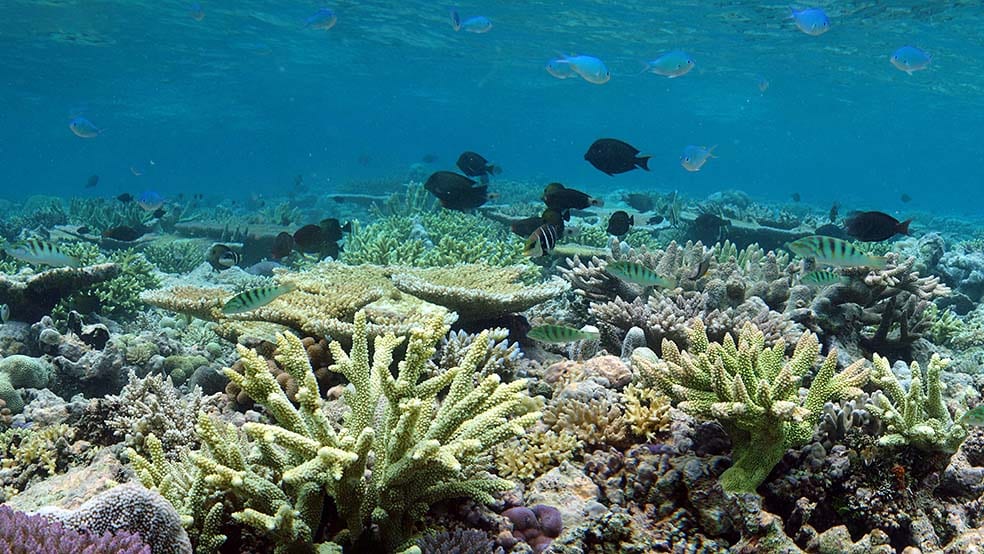Diveplanit readers will remember the flurry of media activity following 2016’s Great Barrier Reef bleaching event. Images of bleached white coral on Lizard Island’s fringing reef were shared by media all over the world, many claiming the Great Barrier Reef dead. But a recent expedition led by the Coral Sea Foundation’s Dr Andy Lewis found otherwise.
Dr Lewis has just completed an 18-night expedition to the Northern Great Barrier Reef with students from Victoria’s Geelong College, and shares some great news about coral recovery at Lizard Island, which was heavily impacted by cyclones and bleaching in the 4-year period from 2014-2017.
“The cyclones and bleaching events took a heavy toll on the colourful branching corals from the Family Acroporidae, with almost complete removal of adult colonies around the island after the summer of 2016. However, our field observations in mid-2016 showed that there were certain locations where juvenile Acroporid corals had begun to grow, and our surveys of the Giant Clam populations in Watsons Bay in 2017 showed that hundreds of small corals from more than 20 species had become established at that site, even settling directly on the clam shells in many cases.”

Dr Lewis returned to the island this year and was able to photograph the same corals growing on the Giant Clam shells to get an idea of their growth rate.
“The results were quite astounding, with most colonies doubling or even tripling in size in only 50 weeks.”
During the expedition a series of underwater video surveys were complete on the site, which returned density estimates of almost two juvenile corals per square meter.
“Given the fast growth rates of these corals and their abundance, these figures indicate that the Acroporid coral assemblage at this Clam Gardens site will recover quickly if undisturbed for another couple of years.”
Take a look at these amazing before and after shots!
July 2017
June 2018








Not all places around Lizard Island indicated the same speedy recovery signs, but pleasingly, all the sites visited over the course of this year’s expedition showed visible signs of coral recruitment, which were not evident just 12 months ago.
“We were particularly excited to find very high numbers of juvenile corals on the inner edge of North reef, approaching 10-20 corals per square metre, which is the highest density we have seen at Lizard Island so far. The source of these new coral recruits is unknown, as most adult colonies in the Lizard Island area were killed during the bleaching and therefore could not have contributed larvae in recent years, but we do know that Acroporid larvae may stay viable for over a month during their pelagic phase, so it appears that adult corals on other reefs in the GBR have seeded the Lizard Island area.
“At some stage in the future, genetic fingerprinting techniques might be used to pinpoint the location of the parents of these new corals at Lizard Island, but for now we are very grateful that these young corals are growing so well.”
According to Dr Lewis, “While there is no doubt that the reefs of the northern Great Barrier Reef around Lizard Island will need many years of undisturbed conditions to return to a state of high coral cover, there is also no doubt that the fundamental recovery potential of the reef is intact and that the recovery is already underway.”
Understanding the speed and dynamics of that recovery is now a research priority for scientists.
“The Great Barrier Reef has evolved over the last 30 million years in a setting where it is continually recovering from various disturbances (sea-level change, cyclones, crown-of-thorns starfish), and our mission is to understand how that inherent recovery potential copes with the added stresses caused by the recent broad-scale bleaching events.”
“I think it is very important that people understand that the Great Barrier Reef, even in its presently battered state, is still an amazing place to visit, that it is certainly not “dead” or “dying”, and that now more than ever, it deserves our most urgent protection efforts.”
The Coral Sea Foundation team works hard to ensure that information on the status of the reefs they visit is available and clearly explained to both scientific and general audiences. To support the Foundation’s work, which includes the mentoring and training of Sea Women of Melanesia, giving them skills to identify areas suitable for ecotourism and marine reserves, you can donate via their gofundme campaign, or purchase something from the selection of amazing coral imagery Foundation’s Redbubble Store.

If you liked this, you may also like:
- Great news for our Great Barrier Reef – 97% improvement in water quality
- Best Diving Places on our Great Barrier Reef
- Is the Great Barrier Reef dead? No. But it’s time to get global to save it.
- The Great Barrier Reef’s Far Northern Reefs; alive, kicking and stunning!
- How the Sea Women of Melanesia can save Papua New Guinea’s coral reefs



